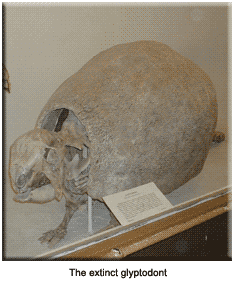From 18,000 to 10,000 years ago, the last Ice Age (or Pleistocene Epoch) occurred. Irregularities in the Earth’s rotation and orbit resulted in a reduction in the amount of solar radiation that reached the planet’s surface. This led to glacial growth and cold climates.
The formation of glaciers lowered sea levels and exposed land masses that had previously rested underwater. In this manner, the land bridge across the Bering Strait was revealed. Ice sheets covered North America, Antarctica, and Europe, profoundly affecting the geography of these continents.
 North American Ice Age mammals included woolly mammoths, mastodons, and giant ground sloths that weighed more than three tons and stood almost 20 feet tall. The glyptodont was a turtle-like creature that weighed more than one ton. The Ice Age menagerie also included the usual assortment of sabertooth cats, giant lions, and gargantuan bears.
North American Ice Age mammals included woolly mammoths, mastodons, and giant ground sloths that weighed more than three tons and stood almost 20 feet tall. The glyptodont was a turtle-like creature that weighed more than one ton. The Ice Age menagerie also included the usual assortment of sabertooth cats, giant lions, and gargantuan bears.
Despite such formidable conditions, Asiatic peoples gradually began to venture across the Bering Strait. The exact origins of these prehistoric peoples is a matter of great interest to modern scholars, but a definitive conclusion has not been reached. Using such techniques as Radiocarbon Dating, scientists have gradually narrowed their views to two theories—the Clovis-First Model and the Early-Entry Model.